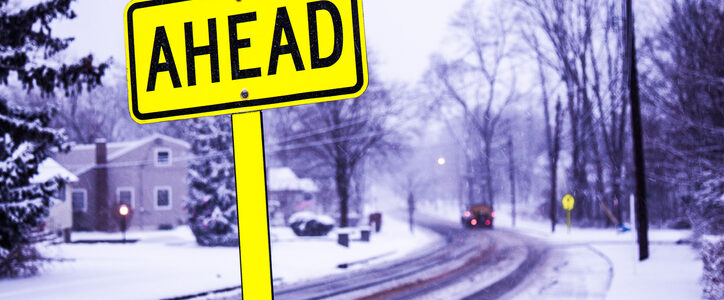There is no escaping winter weather.
All you have to do is watch one nightly news show to witness the devastation winter weather is having on Americans across the country. From record snowfall out west to severe weather in the deep south, the winter of 2022-23 continues to set records. Whether you manage a fleet of cars for a delivery service, logistics company, or a team of outside sales professionals, maintaining high safety standards should be one of your priorities.
Winter weather is often unpredictable no matter where you live in the United States, and this is particularly true in the Northeast. To protect both your employees and the vehicles they operate, you should devote the time and financial resources to conduct driver safety training. Teaching driving safety tips can help reduce the number of business-related accidents, which can then result in lower insurance costs.
The importance of driver safety training is emphasized by two statistics from 2020. Winter weather caused 374 fatal crashes and an estimated more than 25,000 accidents that produced at least one injury.
Let’s review a few winter weather driving safety tips.
Be Prepared
Preparing for the onset of winter weather goes a long way toward developing a successful safety strategy. Start by testing every car battery and ensuring the heating systems are in good operating condition. Winter tires should possess deeper, more flexible treads to help the tires dig deep into the snow for improved traction. Follow the suggestion listed in the operating manual for the proper tire pressure during the cold-weather months of the year. Ensure company vehicles have winter wiper blades in good working condition and use wiper fluid that avoids freezing at a temperature as low as minus 32 degrees Fahrenheit.
Finally, always keep the gas tank at least half-full to prevent the gas line from freezing.
Start Your Engine
Before any of the company drivers slide into the front seat to start a vehicle engine, they should first clean the side mirrors and external camera lenses. Remove ice and snow from every sensor to ensure the proper functioning of assistive driving features such as an automatic emergency braking system. Warm every vehicle up before taking the vehicle out for a drive. Car engines take longer than normal to reach the optimal temperature when started in frigid weather. Never warm up a car in a garage, even if the garage door is open. Carbon monoxide poisoning is called the silent killer for a good reason.
Patience is a virtue when operating a motor vehicle in winter. If you receive a forecast of an incoming storm, delay the start of travel plans until the storm either loses its punch or leaves the area.
While on the Road
Keep the windshield wipers moving at full speed, even if you experience a lull in winter precipitation. Put six seconds of travel time between you and any vehicle that you follow. Add six more seconds for snow plows to prevent ice and snow from collecting on windshields. Patience is also a virtue while on the road. Give your team more than the usual amount of time to reach their destinations and if possible, only allow drivers to travel during daylight hours. Because winter weather can cause road closings, drivers need to pay attention to signs that indicate a significant change in their travel plans.
Although increasing the distance between a driver’s car and another vehicle enhances safety, the same positive effect happens when your drivers add braking time on every type of road and highway. Your drivers should follow the timeless advice of turning on the headlights when it snows and when they encounter foggy weather conditions.
AAA offers tips on how to avoid a car accident during winter weather:
- Do not stop a vehicle when traveling uphill
- Slowly accelerate and deaccelerate
- Steer in the direction of a skid
- Do not turn on the cruise control
- Pull vehicles off the road whenever drivers experience whiteout conditions
The Bottom Line: Training is Everything
Two types of driver training can help decrease the number of accidents: classroom and hands-on training. Classroom training should cover winter weather driving safety tips, as well as educate every driver about the capabilities of their vehicles, such as how to maximize the benefits of safety features like traction control and the anti-lock braking system (ABS).
Your drivers represent the frontline in following winter weather driving safety tips. Make sure they are properly trained before sending them out during the worst weather winter has to offer.
There for You: Acadia Insurance
At Acadia, we’re all about helping businesses throughout the Northeast thrive. Our mission is to provide superior service and product as close to you as possible, providing you with the backing you need to proceed with confidence.
We understand what you want most from your insurance is security and peace of mind. That means knowing you are backed by an insurance company who will support you every step of the way to help you protect your business.
With Acadia, not only can you get coverage tailored to your needs, but you will also receive support from dedicated claims professionals to guide you through the claim process in the event of a loss. That way, you know exactly what to expect. Knowing your claims professional by name and a hand shake – that’s “Closer Coverage”. Get to know more about how we work and find an agent near you by going to the Find an Agent section on our public website (www.acadiainsurance.com).
Acadia is pleased to share this material for the benefit of its customers. Please note, however, that nothing herein should be construed as either legal advice or the provision of professional consulting services. This material is for informational purposes only, and while reasonable care has been utilized in compiling this information, no warranty or representation is made as to accuracy or completeness. Recipients of this material must utilize their own judgment in implementing sound risk management practices and procedures.




